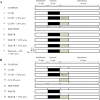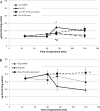Sevoflurane postconditioning is not mediated by ferritin accumulation and cannot be rescued by simvastatin in isolated streptozotocin-induced diabetic rat hearts
- PMID: 30682140
- PMCID: PMC6347357
- DOI: 10.1371/journal.pone.0211238
Sevoflurane postconditioning is not mediated by ferritin accumulation and cannot be rescued by simvastatin in isolated streptozotocin-induced diabetic rat hearts
Abstract
Sevoflurane postconditioning (sevo postC) is an attractive and amenable approach that can protect the myocardium against ischemia/reperfusion (I/R)-injury. Unlike ischemic preconditioning (IPC), sevo postC does not require additional induced ischemic periods to a heart that is already at risk. IPC was previously shown to generate myocardial protection against I/R-injury through regulation of iron homeostasis and de novo ferritin synthesis, a process found to be impaired in the diabetic state. The current study investigated whether alterations in iron homeostasis and ferritin mRNA and protein accumulation are also involved in the cardioprotective effects generated by sevo postC. It was also investigated whether the protective effects of sevo postC in the diabetic state can be salvaged by simvastatin, through inducing nitric oxide (NO) bioavailability/activity, in isolated streptozotocin (STZ)-induced diabetic hearts (DH). Isolated rat hearts from healthy Controls and diabetic animals were retrogradely perfused using the Langendorff configuration and subjected to prolonged ischemia and reperfusion, with and without (2.4 and 3.6%) sevo postC and/or pre-treatment with simvastatin (0.5 mg/kg). Sevo postC significantly reduced infarct size and improved myocardial function in healthy Controls but not in isolated DH. The sevo postC mediated myocardial protection against I/R-injury was not associated with de novo ferrtin synthesis. Furthermore, simvastatin aggravated myocardial injury after sevo postC in STZ-induced DHs, likely due to increasing NO levels. Despite the known mechanistic overlaps between PC and postC stimuli, distinct differences underlie the cardioprotective interventions against myocardial I/R-injury and are impaired in the DH. Sevo postC mediated cardioprotection, unlike IPC, does not involve de novo ferritin accumulation and cannot be rescued by simvastatin in STZ-induced DHs.
Conflict of interest statement
The authors have declared that no competing interests exist.
Figures



Similar articles
-
N-Acetylcysteine Restores Sevoflurane Postconditioning Cardioprotection against Myocardial Ischemia-Reperfusion Injury in Diabetic Rats.J Diabetes Res. 2016;2016:9213034. doi: 10.1155/2016/9213034. Epub 2015 Dec 13. J Diabetes Res. 2016. PMID: 26783539 Free PMC article.
-
Diabetes blockade of sevoflurane postconditioning is not restored by insulin in the rat heart: phosphorylated signal transducer and activator of transcription 3- and phosphatidylinositol 3-kinase-mediated inhibition.Anesthesiology. 2011 Jun;114(6):1364-72. doi: 10.1097/ALN.0b013e31820efafd. Anesthesiology. 2011. PMID: 21368653
-
Protection by Nitric Oxide Donors of Isolated Rat Hearts Is Associated with Activation of Redox Metabolism and Ferritin Accumulation.PLoS One. 2016 Jul 22;11(7):e0159951. doi: 10.1371/journal.pone.0159951. eCollection 2016. PLoS One. 2016. PMID: 27447933 Free PMC article.
-
The paradigm of postconditioning to protect the heart.J Cell Mol Med. 2008 Apr;12(2):435-58. doi: 10.1111/j.1582-4934.2007.00210.x. Epub 2007 Dec 20. J Cell Mol Med. 2008. PMID: 18182064 Free PMC article. Review.
-
Effects of diabetes on myocardial infarct size and cardioprotection by preconditioning and postconditioning.Cardiovasc Diabetol. 2012 Jun 13;11:67. doi: 10.1186/1475-2840-11-67. Cardiovasc Diabetol. 2012. PMID: 22694800 Free PMC article. Review.
Cited by
-
Sevoflurane protects against ischemia-reperfusion injury in mice after total knee arthroplasty via facilitating RASD1-mediated protein kinase A pathway activation.Aging (Albany NY). 2021 May 12;13(9):13333-13348. doi: 10.18632/aging.103899. Epub 2021 May 12. Aging (Albany NY). 2021. PMID: 33982674 Free PMC article.
-
Interaction of Cardiovascular Nonmodifiable Risk Factors, Comorbidities and Comedications With Ischemia/Reperfusion Injury and Cardioprotection by Pharmacological Treatments and Ischemic Conditioning.Pharmacol Rev. 2023 Jan;75(1):159-216. doi: 10.1124/pharmrev.121.000348. Epub 2022 Dec 8. Pharmacol Rev. 2023. PMID: 36753049 Free PMC article. Review.
-
Inactivation of TOPK Caused by Hyperglycemia Blocks Diabetic Heart Sensitivity to Sevoflurane Postconditioning by Impairing the PTEN/PI3K/Akt Signaling.Oxid Med Cell Longev. 2021 Apr 23;2021:6657529. doi: 10.1155/2021/6657529. eCollection 2021. Oxid Med Cell Longev. 2021. PMID: 33986917 Free PMC article.
-
Sevoflurane postconditioning reduces myocardial ischemia reperfusion injury-induced necroptosis by up-regulation of OGT-mediated O-GlcNAcylated RIPK3.Aging (Albany NY). 2020 Nov 20;12(24):25452-25468. doi: 10.18632/aging.104146. Epub 2020 Nov 20. Aging (Albany NY). 2020. PMID: 33231560 Free PMC article.
-
The Molecular Mechanisms of Iron Metabolism and Its Role in Cardiac Dysfunction and Cardioprotection.Int J Mol Sci. 2020 Oct 24;21(21):7889. doi: 10.3390/ijms21217889. Int J Mol Sci. 2020. PMID: 33114290 Free PMC article. Review.
References
-
- Murry CE, Jennings RB, Reimer KA. Preconditioning with ischemia: a delay of lethal cell injury in ischemic myocardium. Circulation. 1986;74(5):1124–36. Epub 1986/11/01. . - PubMed
-
- Zhao ZQ, Corvera JS, Halkos ME, Kerendi F, Wang NP, Guyton RA, et al. Inhibition of myocardial injury by ischemic postconditioning during reperfusion: comparison with ischemic preconditioning. Am J Physiol Heart Circ Physiol. 2003;285(2):H579–88. Epub 2003/07/16. 10.1152/ajpheart.01064.2002 [pii]. . - DOI - PubMed
-
- Chevion M, Leibowitz S, Aye NN, Novogrodsky O, Singer A, Avizemer O, et al. Heart protection by ischemic preconditioning: a novel pathway initiated by iron and mediated by ferritin. J Mol Cell Cardiol. 2008;45(6):839–45. Epub 2008/09/27. S0022-2828(08)00580-4 [pii] 10.1016/j.yjmcc.2008.08.011 . - DOI - PubMed
-
- Drenger B, Ostrovsky IA, Barak M, Nechemia-Arbely Y, Ziv E, Axelrod JH. Diabetes blockade of sevoflurane postconditioning is not restored by insulin in the rat heart: phosphorylated signal transducer and activator of transcription 3- and phosphatidylinositol 3-kinase-mediated inhibition. Anesthesiology. 2011;114(6):1364–72. Epub 2011/03/04. 10.1097/ALN.0b013e31820efafd . - DOI - PubMed
Publication types
MeSH terms
Substances
LinkOut - more resources
Full Text Sources
Medical

